Author: Alfred@Gametorich
Recently, with the strong performance of cryptocurrencies like CRCL and HOOD, many investors have raised several valuable questions: "If the stablecoin bill is truly passed, where will the market's incremental growth appear?" "Why do tokens like SBET and BMNR surge when they ride the Ethereum hype?" "Is there a connection between RWA opportunities and Ethereum?" "Why do you firmly believe in ETH regardless of short-term price fluctuations?" For these different questions, we have provided fragmented answers before. This article will systematically organize the responses, offering a summary from a foundational logic and a longer-term perspective, while also serving as a supplement to previous reports.
"The rise of ETH is not driven by the purchases or promotions of one or two institutions; it is a collective choice of mainstream institutions during a transformative layout, and the critical point of trend change is approaching."
I. Starting from the Data
Stablecoins have achieved a development speed that exceeds market expectations, with a total market capitalization reaching a historical high of $258.3 billion. The U.S. "Genius" bill has passed the Senate vote and is now in the Republican-led House stage, with Trump calling for the U.S. stablecoin bill to complete the legislative process before the August congressional recess. Hong Kong's "Stablecoin Regulation" has been passed and will take effect on August 1. U.S. Treasury Secretary Yellen predicts that if the U.S. stablecoin bill is passed, the market capitalization of stablecoins could rapidly grow to over $2 trillion in the coming years (more than 10 times the current value). Meanwhile, asset tokenization is one of the fastest-growing markets aside from stablecoins, with RWA growing from $5.2 billion in 2023 to the current $24.3 billion, an increase of 460%.

Currently, the total market capitalization of traditional finance exceeds $400 trillion, the total market capitalization of the crypto market is $3.3 trillion, the total market capitalization of stablecoins is $250 billion, and the total market capitalization of RWA is $24 billion. According to industry forecasts from Standard Chartered Bank, Redstone, RWA.xyz, etc., by 2030-2034, 10%-30% of global assets may be tokenized, amounting to $40-$120 trillion, with the total market capitalization of RWA expected to expand to over 1,000 times its current value.
What other businesses are the most proactive players in stablecoins and cryptocurrency ETFs, like BlackRock, laying out?
(1) BlackRock BUIDL Fund: BUIDL (BlackRock USD Institutional Digital Liquidity Fund) is a blockchain-based tokenized dollar-pegged fund launched by BlackRock, using tokenization to represent underlying assets (mainly U.S. Treasury bonds). Currently, its AUM has reached $2.86 billion (11.7% of the RWA market), with 95% of the funds deployed on Ethereum.
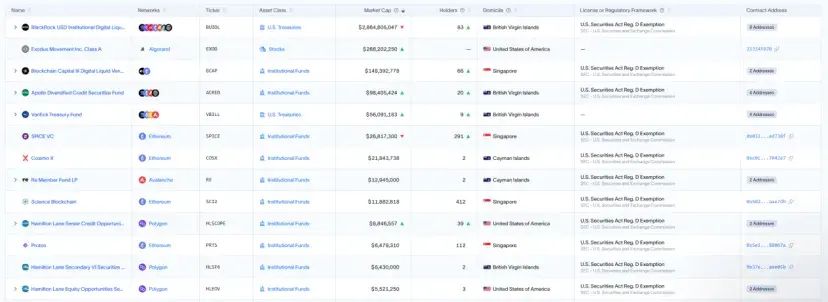
(2) Securitize: An asset tokenization company led by BlackRock and Jump, with participation from institutions like Coinbase. In addition to issuing BUIDL with BlackRock, it has collaborated with several traditional financial institutions to issue various tokenized products: tokenizing private equity funds in partnership with Hamilton Lane; exploring the issuance of tokenized investment products with VanEck; tokenizing part of Apollo's private credit and alternative investment products; and assisting KKR in fund tokenization. The market capitalization of tokenized products issued through Securitize has reached $3.7 billion (15% of the RWA market), with 80% deployed on Ethereum.
(3) Franklin Templeton BENJI Fund: BENJI (BENJI Tokenized Fund) is a tokenized fund launched by Franklin Templeton that converts traditional assets (money market funds or bonds) into digital tokens, enabling asset digitization and fragmentation, allowing small investors to participate, while supporting smart contract functions for profit distribution or reinvestment. Currently, its AUM is $743 million (3% of the RWA market), with 59% of the funds deployed on Stellar and 10% on Ethereum.
There are many more traditional financial institutions promoting asset on-chain and asset tokenization businesses. The current wave of institutional adoption represents the culmination of years of infrastructure development finally moving towards large-scale deployment.
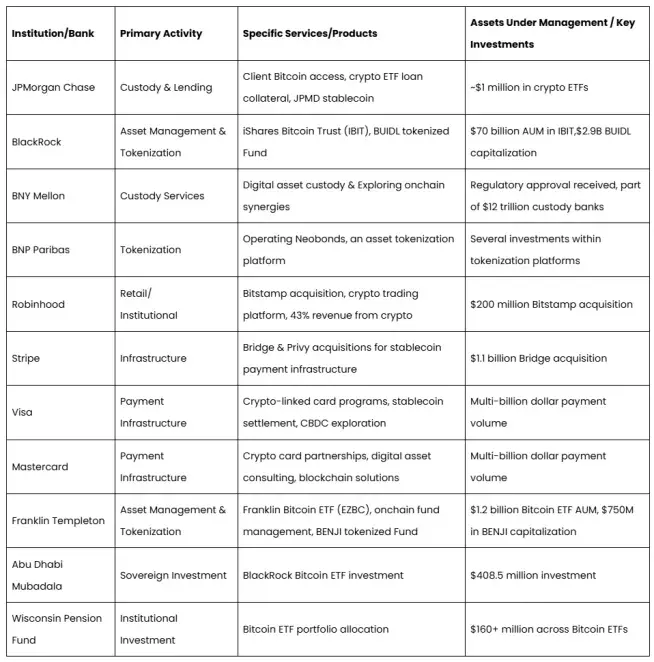
II. Reassessing RWA
RWA (Real-World Assets) refers to the digitization and mapping of tangible or intangible assets from the real world (such as real estate, artworks, bonds, stocks, commodities, etc.) into digital tokens or assets on the blockchain through blockchain technology or tokenization methods. Broadly speaking, I believe that RWA in the industry mainly corresponds to the on-chain and tokenization of any assets beyond blockchain-native assets, allowing the rights, circulation, and settlement of the underlying assets to be fully completed through the blockchain.
Tokenization has the following structural advantages:
Programmability - Smart contract-driven asset management innovation: Programmability refers to encoding the rules, conditions, and execution logic of assets into automated, verifiable code through smart contracts on the blockchain. Tokenized assets can embed functions such as dividends, redemptions, and staking, eliminating manual intervention. This shifts asset management from static holding to dynamic management, evolving from manual data transmission to automated updates on-chain.
Settlement revolution - Efficiency improvement and risk control: Tokenization enables point-to-point instant settlement through the blockchain, replacing the lengthy T+2 clearing cycle that has plagued the traditional financial system for years. Both parties in a transaction can directly transfer ownership through tokens without the need for centralized intermediaries, reducing counterparty risk and capital requirements.
Liquidity revolution - The core of traditional finance embracing crypto: Tokenization significantly enhances asset liquidity by dividing traditionally low-liquidity assets (such as real estate, private equity, etc.) into standardized small tokens for trading in the secondary market, combined with the increasingly mature DeFi system. The unique 7*24 trading environment of blockchain further amplifies this effect.
Whenever an asset goes on-chain, settlement efficiency improves, and idle assets are utilized by DeFi. "The faster the speed of value settlement, the higher the frequency of capital reinvestment, thus further expanding the overall economic scale. Business models will no longer rely on charging for the [liquidity] process but will create new revenue sources through the [momentum] effect" (-Sumanth Neppalli). This is the core of traditional finance's integration with crypto.
- Global accessibility - Breaking geographical barriers of capital fragmentation: Tokenization leverages the distributed nature of blockchain, allowing global investors to access tokenized assets via the internet without complex cross-border intermediaries or local accounts, significantly expanding the investor base while reducing distribution costs. The global application of stablecoins is the best testimony to this, and this trend is emerging in more markets like the stock market.
What assets are being tokenized?
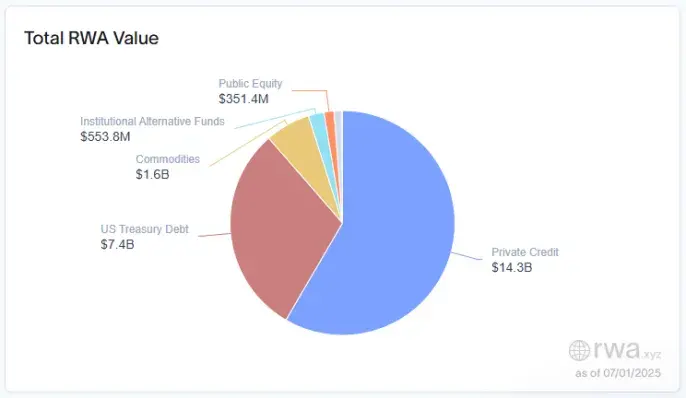
Private credit - The largest RWA tokenization field: Contrary to most perceptions, private credit is currently the largest market for asset tokenization, with a total scale of $14.3 billion, accounting for 58.8% of the total RWA scale. Figure, Tradable, and Maple are providing active loans of $10.6 billion, $2 billion, and $800 million, respectively.
Government bonds - The starting point for traditional institutions' tokenization: The market size of tokenized government bonds has reached $7.4 billion, accounting for 30% of the total RWA scale, with representatives including BlackRock's BUIDL; Franklin Templeton's BENJI; Superstate's USTB; and Ondo Finance's USDY. Traditional financial institutions are beginning to explore the development of on-chain derivative financial products and DeFi integration based on tokenized government bond products.
The tokenized stock market is accelerating realization: On June 30, cryptocurrency exchanges Kraken and Bybit announced the launch of tokenized U.S. stocks and ETFs through xStocks, enabling 5*24 hour trading. Although these are not blockchain-native stocks, they allow participation in price difference trading through stock tokenization, breaking the geographical boundaries of the U.S. stock market. Meanwhile, Robinhood announced it is building the "Robinhood Chain" on the Arbitrum blockchain, aimed at supporting decentralized management of future asset ownership. This marks its transformation from a traditional brokerage to a blockchain-native platform, dividing stock tokenization into three phases to integrate blockchain for composability advantages. At the same time, Coinbase has positioned tokenized stocks as a "top priority," with its Chief Legal Officer Paul Grewal actively seeking approval from the U.S. Securities and Exchange Commission (SEC) to offer blockchain-based stock trading services, utilizing its Base Layer 2 network as a potential infrastructure for future tokenized stock settlements. This year, we may witness these leaders launch popular stocks native to the blockchain.
Commodity tokenization primarily focused on gold: Gold accounts for nearly 100% of tokenized commodities. Paxos Gold (PAXG) leads with a market capitalization of approximately $850 million.
Private equity tokenization is actively exploring: Private equity is the ultimate goal of tokenization, as this technology can solve structural issues that have persisted for decades, transforming the extremely poor liquidity of traditional private equity.
III. Stablecoins - RWA - DeFi
Stablecoins are the most important underlying foundation for traditional finance's integration into the blockchain, making currency programmable and decentralized, serving as the basis for the circulation and settlement of all on-chain financial assets. Dr. Xiao Feng, Chairman of Hashkey Group, and Professor Meng Yan have shared in interviews that "the U.S. presidential team and Congress are relatively frank and transparent about the motivations behind stablecoin legislation. The first is to modernize the U.S. payment and financial system, and the second is to consolidate and enhance the position of the dollar, creating trillions of dollars in demand for U.S. Treasury bonds in the coming years." "For the U.S., Bitcoin as a national reserve is secondary; stablecoins in dollars are the primary concern and core interest of the U.S."
The rapid development of RWA in this cycle is attributed to institutions continuously exploring new integration methods and promoting the legislative process of digital asset market structure bills. Once the stablecoin and market structure bills are completed, a large number of assets will be rapidly pushed on-chain, with transactions, profits, settlements, and other processes operating on the native blockchain, using stablecoins as the basic currency unit and value carrier.
After a large number of assets go on-chain, DeFi will begin to play a role, integrating newly on-chained assets with increasingly mature DeFi protocols to achieve efficiency, automation, and compliance. This will drive the creation of derivative products and the generation and distribution of high liquidity returns. This cycle may represent a new wave of robust development opportunities for the entire DeFi ecosystem since the DeFi Summer.
Cases of RWA and DeFi Integration
- Securitize connects to the DeFi system through sTokens:
Securitize, the world's largest tokenized asset issuer, cannot directly use its issued native tokenized securities in DeFi protocols due to compliance considerations. Tokens must first be deposited into sVault, where a DeFi-compatible version, sTokens, is minted, allowing access to the existing DeFi ecosystem.
BlackRock BUIDL and Euler Protocol: Securitize's sBUIDL (the derivative token of BUIDL) has been integrated into the Euler lending protocol on Avalanche. Holders can deposit sBUIDL into the sToken Vault to borrow other assets while continuing to earn daily yields from BUIDL.
Apollo ACRED and Morpho Protocol: The sToken version of ACRED (sACRED) operates on Polygon PoS through Morpho, allowing holders to use sACRED as collateral to borrow USDC, automatically reinvesting to amplify returns.
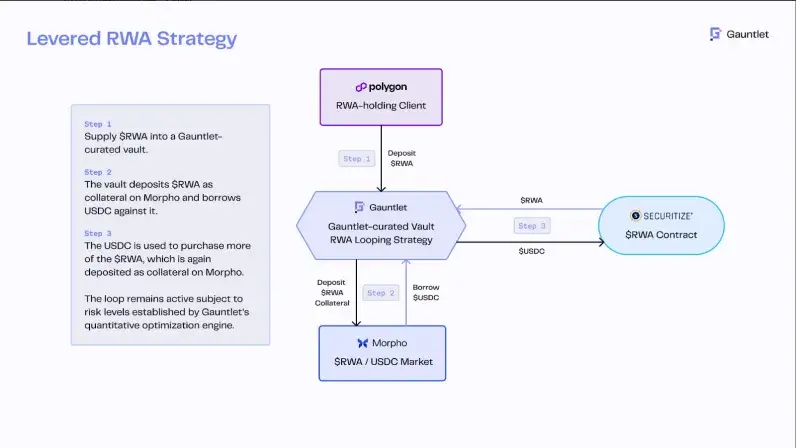
- Ethena's USDtb integration with BUIDL to achieve stable yield floors
The Ethena Risk Committee has approved the use of USDtb as the primary supporting asset when the Delta neutral financing strategy reaches a local minimum. 90% of USDtb's reserves are held in BlackRock's BUIDL fund, serving a dual purpose: providing low-risk collateral for margin trading on centralized exchanges and offering compliant Treasury exposure in adverse financing environments.
"USDe's support for USDtb has indirectly catalyzed explosive growth in complex DeFi yield strategies, particularly facilitating the robust money market for Pendle's principal tokens (PT) and yield tokens (YT) — traditional finance views these tools as part of the interest rate market. During periods when crypto derivatives financing rates turn negative or compress significantly, the support from USDtb provides crucial yield floor stability (typically at an annual rate of 4-5%). This predictable minimum yield base is vital for PT token valuation and AAVE's oracle system, enabling more accurate pricing models and safer liquidation mechanisms."
Currently, traditional financial institutions are starting to explore the development of on-chain derivative financial products and the compliance integration of DeFi, based on tokenized government bond products originating from stablecoins.
IV. ETH is the mainstream choice for institutions
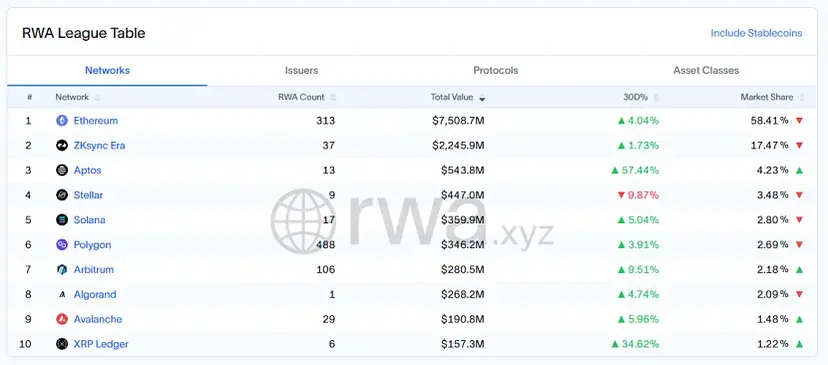
From the data, ETH remains the primary public chain for institutions to tokenize assets, with a tokenized market capitalization of $7.5 billion on ETH, accounting for 58.41% of the total scale. The tokenized market capitalization on ETH's L2 ZKsync Era is $2.245 billion, accounting for 17.47%, while Aptos, the leading public chain among others, has a tokenized market capitalization of $540 million, accounting for about 4.23%.
From a foundational logic perspective, there are three reasons why institutions prefer ETH as the main battlefield for asset on-chainization:
Ethereum has the highest security among all public chains. With a decade of accumulated security records, it has not experienced severe issues like downtime. When Ethereum upgraded from PoW to PoS, it completed the core architecture upgrade without downtime, described as "changing the engine while the plane is flying." The stability demonstrated by excellent technical foundations and organizational integration aligns with the prudent principles of institutions making new business layouts.
It has the most mature DeFi ecosystem and the best liquidity, with the most developed DeFi protocols. The most innovative product mechanisms mostly exist on Ethereum, allowing institutions to quickly access mature DeFi systems and enjoy the best liquidity after going on-chain with ETH.
Extremely high decentralization and global business reach also serve as a balancing center for the interests of large institutions and global investors. One reason stablecoins are strategically significant for the U.S. is that they achieve decentralized global reach through on-chain mechanisms, breaking down the past political divisions of national currency barriers and pushing dollar equivalents globally through the network. Asset tokenization is similar; for example, recent tokenization of U.S. stocks allows those who previously could not invest in U.S. stocks to bypass national entry barriers and participate in U.S. stocks on-chain. Benefiting from the best liquidity and influence, ETH is the preferred public chain for global business reach, and due to its decentralized nature, it serves as a balancing center for the interests of large institutions and global investors. Large institutions in sovereign countries are unlikely to choose a public chain that is completely dominated and controlled by another country to issue products and participate in large financial activities.
Let's see what Etherealize has to say
EF has undergone significant functional differentiation and specialization, reorganizing into three major business groups while separating specific functions to external organizations, leading to the birth of Etherealize. It is positioned as the "institutional marketing and product pillar" of the Ethereum ecosystem, focusing on handling connections with traditional finance and Wall Street to accelerate Ethereum's adoption among institutions.
Etherealize believes that ETH should not be evaluated as a tech stock but as a new category of asset: ETH is digital oil — an asset that powers, guarantees, and reserves the new financial system for the internet.
"The traditional financial system is at the beginning of a structural transformation from analog infrastructure to digital-native architecture. Ethereum is expected to become the foundational software layer — similar to an operating system like Microsoft Windows — upon which the new global financial system will be built.
When all of this is realized, ETH will become the foundational asset of a comprehensive global platform that encompasses the future of finance, tokenization, identity, computing, artificial intelligence, and more. This inherent complexity makes it harder to define ETH, especially compared to simpler value-storing assets like Bitcoin — but it also makes ETH strategically more valuable and implies that ETH has greater long-term potential."
At the same time, ETH is not just a cryptocurrency; it is a multifunctional asset with roles including: computational fuel; a value-storing asset with accompanying yields; original settlement collateral; a deflationary asset; a manifestation of tokenized economic growth; reserve trading pairs; and a strategic reserve asset.
Therefore, ETH cannot be accurately valued through discounted cash flow methods. Instead, ETH must be viewed from the perspective of strategic value storage and utility-driven scarcity. ETH powers the digital economy, secures the safety of the digital economy, captures value from the growth of the digital economy, and possesses inherent scarcity due to its dynamic supply and issuance cap. As the global economy transitions to tokenized infrastructure, ETH will become indispensable, not just as fuel but as the native asset of the monetary and settlement layers of the future financial system.
Why is ETH lagging behind BTC?
The answer is simple: Bitcoin's narrative has been accepted by institutions, while Ethereum's narrative has not. In contrast, Ethereum's value proposition is harder to define — not because it is weaker, but because it is broader. Bitcoin is a single-use value-storing asset, while Ethereum is a programmable foundation supporting the entire tokenized economy.
The process of accelerating ETH's repricing is underway:
Surge in demand: Institutions have begun large-scale rapid adoption and deployment of tokenized assets and financial infrastructure on Ethereum, as evidenced by the data in this article.
Accelerated demand for native crypto yields: As institutions trend towards building on ETH, the emergence of Ethereum ETF staking is merely a matter of time, and the appearance of institutional physical subscription/redemption models will significantly enhance institutional interest in ETH staking yields.
Strategic accumulation of ETH: A competition is emerging within the Ethereum ecosystem to accumulate ETH as a currency premium value-storing asset. Recently, the U.S. publicly listed company Bitmine Immersion Technologies raised $250 million to initiate an ETH financial strategy, driving its stock price from $4 to a peak of $74 in two days, an increase of over 180%.
ETH as an institutional asset: The unique characteristics of ETH — original collateral, neutrality, yield, and global utility — make it the preferred reserve asset for institutions and globally.
In summary, ETH is not the only long-term choice for institutions entering the blockchain, but it is currently the optimal solution for large-scale asset on-chainization. Considering the data, examples, foundational logic, and recent Big News, the trend of ETH being revalued is on the horizon.
References
1. "Beyond Stablecoins"
2. "Real-World Assets in Onchain Finance Report"
3. "The Bull Case for ETH"
4. "Dialogue with Dr. Xiao Feng: U.S. Dollar Stablecoins and RWA"
免责声明:本文章仅代表作者个人观点,不代表本平台的立场和观点。本文章仅供信息分享,不构成对任何人的任何投资建议。用户与作者之间的任何争议,与本平台无关。如网页中刊载的文章或图片涉及侵权,请提供相关的权利证明和身份证明发送邮件到support@aicoin.com,本平台相关工作人员将会进行核查。




